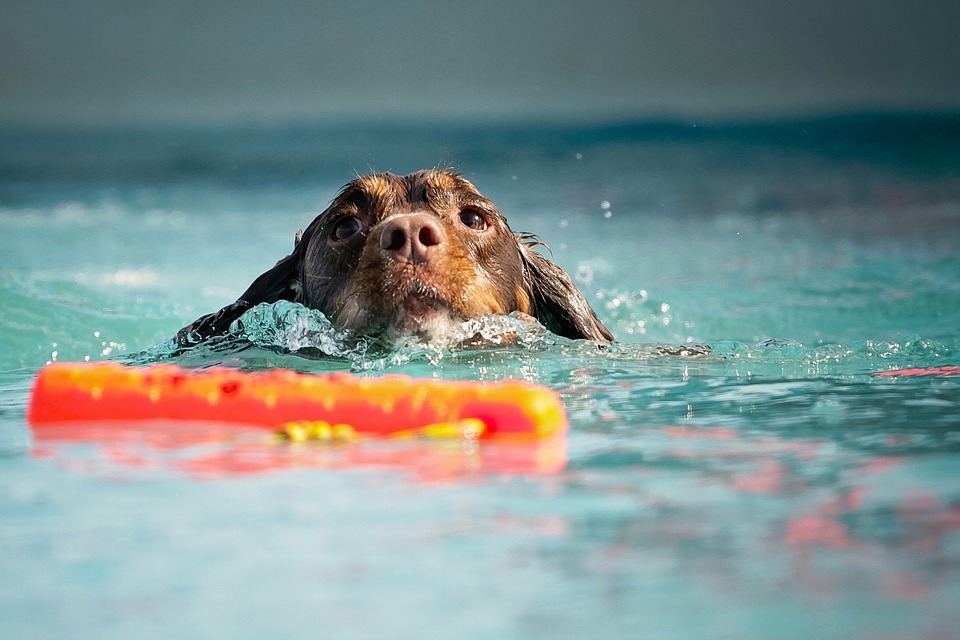
If your dog is recovering from surgery, a recent injury, or is suffering from certain mobility issues, you want to help them in the best way possible.
A study from the Royal Veterinary College (RVC) revealed new information on the canine obesity crisis across the UK, with 1 in 14 dogs proven to be overweight each year. When a dog does not get their daily exercise as a result of painful joints, or is too elderly to maintain their muscle mass, this problem becomes more apparent.
The good news is that there are many treatments available to provide relief for your beloved pet. One of these options is hydrotherapy or canine water therapy.
What is canine hydrotherapy?
Hydrotherapy utilises warm water of around 30°C to improve your dog’s blood circulation and strengthen their muscles. This is done by performing controlled, specific exercises like swimming in a hydrotherapy pool or walking on an underwater treadmill.
Most sessions last 30 minutes on average and the number of appointments required will vary depending on your dog’s condition.
For acute injuries, three may only be required to relieve them from pain. However, dogs with ongoing orthopedic and neurological conditions such as arthritis, cruciate ligament injuries, hip and elbow dysplasia and spinal disorders (wobbler syndrome) will require multiple hydrotherapy sessions.
Many veterinary physiotherapists like Phyiso-Vet have specialist equipment and facilities to provide dog hydrotherapy in Cheshire, ensuring that local patients receive the best care possible with a tailored treatment plan to help them on the road to recovery.
Now that we know what hydrotherapy is, let’s take a look at the key benefits of this aquatic treatment.
- Strengthen muscles and bones
Water exercises can help your dog strengthen muscles and bones, without putting additional stress on its joints. The buoyancy of water creates a weightless environment to reduce pressure on limbs and lower back, while also increasing your dog’s range of motion and flexibility. The gentle resistance of water allows dogs to build strength gradually and steadily – great for agility, working or older dogs of any breed and age.
- Decrease muscle tension & pain
Hydrotherapy also reduces pain by decreasing muscle tension. The warmth and (depending on the depth) complete lack of gravity allow muscles to relax like never before, which can free up any tightness that causes pain for dogs with hip and elbow dysplasia, and osteoarthritis. Additionally, the brain releases endorphins during treatment, producing a calming effect which eases anxiety and stress, thus increasing relaxation further. This combination allows muscles to rest deeply, reducing (or even preventing) potential trigger points or spasms.
- Improves circulation
As a result of muscle relaxation, canine hydrotherapy also helps to improve blood flow in the body. Most of us know warm water is very soothing for muscles, joints and bones. The pressure from rubbing against the current of water is an effective massage, increasing circulation within affected areas.
Movement itself stimulates blood flow naturally by encouraging shifting exercises among other muscular movements which encourages lymphatic drainage often hampered by obesity or arthritis. Subsequently, efficient and cleaner blood flow leads to better nutrition and fewer toxins in the body to help dissolve away lactic acid buildup, as well as reduce stiffness within the joints.
- A happier, healthier dog
It is estimated that there are 12.5 million dogs in the UK, so it’s fair to say that we as a nation love our canine companions. With that said, the massage of dog water therapy, especially when combined with warm water, leads to positive energy and a happy attitude. The treatment makes dogs feel younger than their years because it eases many of the aches and pains that come with age or certain health conditions. The end result is a healthier dog that’s more active, agile and comfortable.
